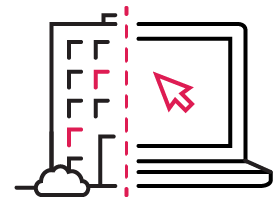Data Integration Strategy: Designing a Future for Your Business
A data integration strategy involves taking a comprehensive look at the data used in your organization and the integration use cases and pain points you need to address, and then developing the best solution for integrating data across platforms and applications.
With all those factors, it’s hard to know where to begin. So, let’s start at the beginning.
What is a Data Integration Strategy?

Based on the strategy developed, you can form a detailed plan to achieve your strategic outcomes. The plan will include what needs to be done, who does it, and when. It also identifies who is accountable for managing it.
All data integration strategies should align with the organization’s business goals and:
- Consider your data use cases and pain points
- Examine data types
- Consider the project budget
- Guide you to a wise, practical, and consistent integration approach
- Enable a solution flexible enough to adapt to changing future needs
Ideally, your integration approach should help you achieve business goals, enable easy data access, and connect the data sources the business needs to be efficient, innovative, adaptable and profitable.
How to Set Long-term Goals for a Data Integration Strategy Within an Organization
Having a long-term view is an essential part of choosing the right enterprise data integration option. If you only focus on your current requirements and infrastructure, then you may need to change your integration processes and solutions in a few years. When you go through the factors in the previous section, think about where your organization may be in the next one, five, or ten years. Some data integration options are better suited to supporting your organization’s long-term needs than others, and you can implement those now rather than needing to switch in the future.
The 10 Main Elements of a Data Integration Strategy Process:

1. Scalability
The amount of data being generated today is mind-boggling compared to just a few years ago, and the rate is only accelerating. Your organization’s workload may change significantly over the next five to ten years. Your data integration strategy requires a scalable approach that’s prepared to handle the data loads of the future and today. One way to handle scaling is to connect it to real-time events and automate resource allocation based on your integration activities.
2. Anytime, Anywhere Access
The rapid adoption of remote work policies because of the 2020 pandemic has further driven the need to create highly accessible data integration resources. Ad hoc data requests, routine integration, and countless other use cases may occur with remote employees, those on business trips, field workers, and other stakeholders outside the physical business location.
You need to consider how you will support remote access, from infrastructure to security and beyond. The user experience should be seamless from both sides of the connection. Your work-from-home staff may need upgrades to their home office equipment as part of this plan so you avoid accessibility pitfalls associated with insufficient Internet speeds, unsecured home networks, and obsolete hardware.
3. Interoperability with Enterprise Solutions
You won’t get far with a data integration strategy that doesn’t account for the enterprise solutions you have in place. Consider:
- Where your data is coming from and going to
- The storage options you currently use
- New types of data storage
- The application programming interfaces (APIs) you can leverage.
Your strategy should move you closer to creating a silo-free enterprise environment that supports massive data movement and transformation.
4. Adaptable Framework
- How agile is your data integration?
- Is it future-proofed to:
- Help drive the adoption of new technologies
- Work with alternative data sources, APIs, and formats
- Adapt to an ever-changing enterprise environment?
An agile data integration strategy uses a framework that can accommodate new technology without a massive expenditure of resources. You can quickly bring in new solutions ahead of the competition and reduce the development workload required to make it work.
5. Where is Your Infrastructure
Many applications and solutions are moving to the cloud or are developed with a cloud-native approach. But on-premises infrastructure also has its strengths in the enterprise.
Accommodate the full range of deployment options to avoid limiting your options in the future. You can decide based on what’s best for a particular solution, rather than trying to force it into an on-premise or cloud data integration strategy.
6. Data Types and User Access
- What data types and sources are you working with?
- Do you need to integrate these or just certain ones?
- Are there data types that you’re likely to work with in the future that are not currently in use in your organization?
By defining exactly what data needs integration, you can avoid choosing solutions that present challenges when working with certain formats or that can’t support future requirements.
- The easiest way to address this is to conduct a data audit. You may discover data types that were not accounted for and some that may need to be replaced.
- The next step is to understand who needs access to the data. Most users only need access to a small portion of your enterprise’s data, and controlling that access is critical from a security standpoint.
7. Regulatory Compliance
Data regulations continue to develop and falling out of compliance can be costly. Data management and privacy are top-of-mind for many stakeholders, and adapting to sweeping changes after the fact can lead to significant development costs and business disruption.
Granular control over the data integration strategy helps your enterprise adapt to new regulations and current requirements. You may already cover future compliance through your data governance policies, but revisiting it allows you to address challenges unique to data integration.
8. Data Security
How do you protect data that is being pulled from multiple sources and variably transformed? Data breaches and losses are another costly concern for enterprises, but you can manage your risks with the right strategy.
The typical type of attack for your industry, the type of data that you need to protect, and the regulations you must follow all inform the method for data security during integration. Some common vulnerabilities include
- Attack opportunities as data moves from one solution to the other
- Internal malicious actors
- Phishing
- Social engineering
A proactive, multi-layered security approach can get ahead of existing and emerging threats.
9. Available Resources and Talent
Implementing a data integration strategy requires access to sufficient resources and specialists. Think about the support you need to deploy data integration across your organization successfully, and how to drive adoption.
You may need a combination of in-house and outsourced staff to handle key parts of data integration, such as
- The initial development and deployment
- Removing data silos from your organization via strong change management plan so stakeholders understand what the strategy means for them and how they can benefit from it
- End-user training and ongoing feedback from stakeholders to shape the data integration solutions you use
10. Business Value
- Exactly how does your organization benefit from a large-scale data integration strategy?
- What results are you hoping to see after a solution is in place?
Identify key metrics, and how they affect the organization positively to increase support for your strategy. You can point out:
- Greater efficiency and productivity
- Improved visibility into the organization’s data
- Potential bottom-line impacts that come from data integration.
The Benefits of a Data Integration Strategy
Gets stakeholders on the same page:
- What are everyone’s goals with this project?
- What challenges do they want to solve through data integration?
- What is the process scope?
When you create a comprehensive strategy, you answer these questions and leave nothing to the imagination.
Better informs the tool and software selection process:
Your data integration strategy requirements influence the software or platform that best suits these needs. If you don’t have a strategy in place, then you could run into a solution mismatch that costs significant time and resources to fix.
Addresses current and future data integration challenges:
You identify problems that stand in the way of data integration in your organization and what you need to change in order to solve them.
Reduces wasted resources:
Your strategy provides a blueprint for data integration and cuts down on resources that could be wasted because of inefficiencies in this process.
Opens up communication channels between affected departments:
An enterprise-wide data integration process should have input from stakeholders outside of the integration team. You can discover new unknown use cases, solutions that need support, and data formats.
Creates a security-centric foundation for data integration:
Consider the security challenges that this process introduces, and how to mitigate the risks that exist to keep your data safe when it moves between solutions through the data integration tool.
Identifies potential data integration pain points:
Talk with end-users throughout the organization to discover the data they would like to access, where they need the most support, and the limitations of their current software. Then incorporate solutions into your strategy.
Empowers organizations to become data driven:
When you improve access to data throughout the organization, you also boost its visibility. Ad hoc data requests and real-time updates can go a long way to influencing business decisions.
Removes data silos in the organization:
When employees can access data across teams and business units, it promotes seamless collaboration between departments.
Maximize the value of your data:
You can use the data in many solutions and use cases, which allows you to get more out of it.
Improves data management:
A comprehensive data integration strategy has many provisions in place for controlling how data moves throughout the organization. So, as new goals, solutions, sources, or requirements arise, managing the change will be easier.
Final thoughts
From the initial development and deployment of new data systems to the need for a change management plan, end-user training, and ongoing feedback, successful data integrations involve many moving parts. A good data integration strategy will consider many other issues not explored here, such as data security, regulatory compliance, and the availability of resources.
Many organizations have decided that relying on an experienced integration partner can simplify and improve the process. Cprime’s skilled IT specialists can help you create and implement a unique strategy for your enterprise.
Explore further with our popular webinar, The Data to Pivot: Enterprise Visibility and Integration of Your Mission Critical Tooling. Then, contact us to discuss your needs.




